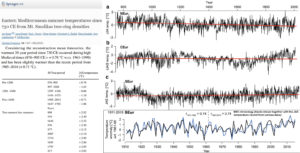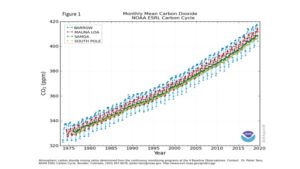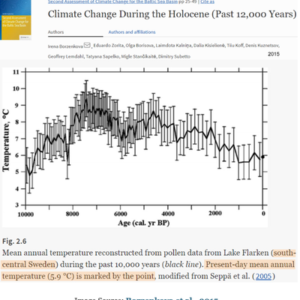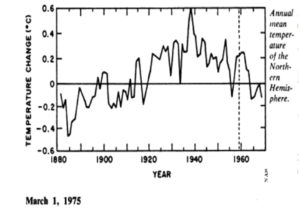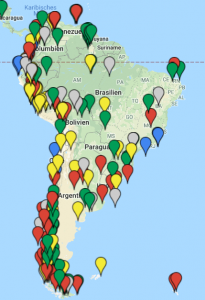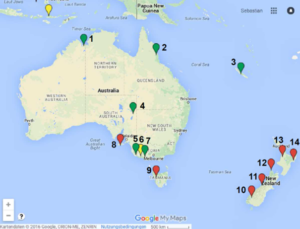by A. Préat, 29 novembre 2019 in ScienceClimatEnergie
1/ Introduction
Comme rappelé dans un précédent article (ici) les événements hyperthermiques sont fréquents tout au long de l’histoire de la Terre. Bien que fréquents et étudiés avec détail, force est de reconnaître que le ‘fin’ mot de leur origine n’est toujours pas connu, sauf à leur attribuer à tous un lien de parenté avec l’un ou l’autre des gaz dits à effet de serre, sans qu’une démonstration en bonne et due forme soit présentée. C’est ce que décortique l’article paru dans SCE (ici) pour un des événements hyperthermiques les plus intenses (événement PETM pour Paleocene-Eocene Thermal Maximum) s’étant déroulé au début de l’ère Cénozoïque il y a environ 56 millions d’années.
Rappelons la succession de ces événements au Cénozoïque, d’abord l’événement PETM, ensuite E-O (Eocene-Oligocene transition with climatic shift), MMCO (Mid-Miocene Climatic Optimum), MPTO (Mid-Pliocene Thermal Optimum) et depuis environ 10 000 ans l’Optimum Holocène. Ces événements montrent tous que la Terre a régulièrement connu de longues périodes chaudes avec des ‘températures moyennes globales’ plus élevées que l’actuelle (voir par exemple Cronin 2010, également mentionné sur de nombreux sites web). L’indicateur climatique communément utilisé , la température moyenne globale est loin d’être parfait (ici et ici). Il ne faut donc pas prendre au pied de la lettre cette notion de ‘température moyenne globale’ car déjà pour aujourd’hui elle est plus que discutable, et pour le passé elle est plus qu’inconnue. Mais il n’en reste pas moins vrai que lors des événements hyperthermiques ou des optima climatiques la température était plus élevée qu’actuellement, nous le savons grâce à de nombreux indicateurs ou ‘proxies’ (voir plus loin). Ces événements ne concernent pas uniquement le Cénozoïque (y compris l’Holocène) mais l’ensemble de l’échelle des temps géologiques au-delà du Cénozoïque, avec parfois des températures fort supérieures à celles du Cénozoïque, comme par exemple au Permien (ici).
2/ L’Optimum Climatique Médieval
Revenons aux temps actuels, c’est-à-dire aux temps historiques. Plusieurs Optima Climatiques se succèdent depuis environ 6000 ans, avec pour la période la plus proche de nous, c’est-à-dire environ 3500 ans, la succession des Optima Climatiques Minoen, Romain, Médiéval et Actuel (Figure 1). Le plus récent est l’Optimum Climatique Médiéval (OCM) dont l’acmé se situe aux alentours de l’an mil. S’agissant de températures à peine plus élevées (1,5°C cfr ici et Le Roy Ladurie, 1967, également 1.0-1.4°C in Easterbrook, 2011), la délimitation précise de cet intervalle par rapport aux périodes encadrantes est difficile et l’OCM est finalement compris du 8ème au 13ème siècle (= le ‘petit optimum du Moyen Age’ d’environ 700 à 1350 sensu Le Roy Ladurie, 1967).
…
…
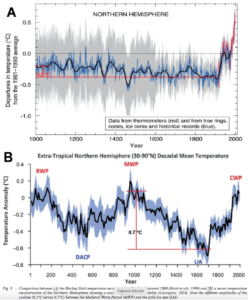
Figure 8 (cfr. Figure 5 in Préat, 2019). Capture d’écran de la Figure 8 de Scafetta (2019) : On the reliability of computer-based climate models. IJEGE, 19, 49-70. En comparant les deux courbes on peut se demander si l’on parle de la même chose! (RWP Roman Warm Period, DACP Dark Age Cold Period ou période froide post-romaine, MWP Medieval Warm Period, LIA Little Ice Age, CWP Current Warm Period). Pour rappel la courbe A du haut, est la fameuse courbe en forme de hockey de Mann et al. 1998 du GIEC.
…
